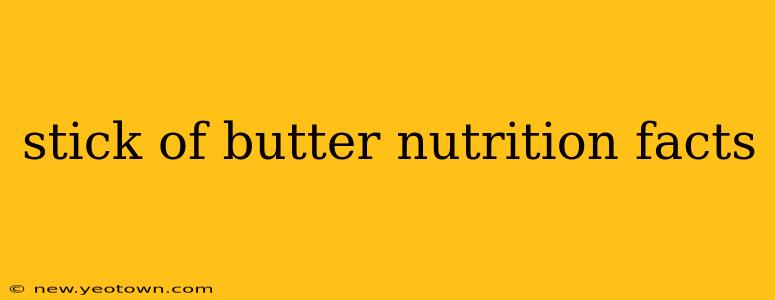Unpacking the Nutritional Powerhouse: A Stick of Butter
Butter. The very word conjures images of golden-brown pastries, fluffy mashed potatoes, and crusty bread. But beyond its culinary magic lies a nutritional profile that’s worth understanding. This isn't just about calories; it's about the specific fats, vitamins, and other components that make up a seemingly simple stick of butter. Let's delve into the details, exploring what makes butter tick, nutritionally speaking.
A standard stick of butter (1/2 cup or 113 grams) typically boasts around 810 calories. Now, before you reach for the low-fat alternative, let's break down why those calories are significant – and not always villainous.
What are the main fats in butter?
Butter's nutritional profile is largely defined by its fat content, and most of that fat comes from saturated and unsaturated fats. While saturated fat has gotten a bad rap in recent years, it's crucial to remember that it's not a single entity. Different saturated fats have different effects on the body. Butter contains various saturated fatty acids, some of which can contribute to raising cholesterol levels while others have less impact. It also contains unsaturated fats, including monounsaturated and polyunsaturated fats, which are generally considered heart-healthy. The balance of these fats is a key factor in its overall nutritional impact.
How much cholesterol is in a stick of butter?
A stick of butter contains a substantial amount of cholesterol, approximately 300mg. Cholesterol is a lipid that plays a crucial role in many bodily functions, but high levels in the blood can increase the risk of heart disease. This highlights the importance of moderate consumption. While dietary cholesterol's effect on blood cholesterol is now debated by experts and its impact on health is less severe than once thought, mindful intake remains advisable.
Is butter a good source of vitamins?
Surprisingly, butter isn't just fat. It's a surprisingly good source of fat-soluble vitamins, particularly vitamin A and vitamin E. These vitamins are essential for various bodily functions, including vision, immune function, and protecting cells from damage. The amount varies depending on the diet of the cow, which is why the sourcing of your butter can make a difference in its nutritional value. Grass-fed butter, for example, often boasts higher levels of these beneficial vitamins and has a different fatty acid profile.
What are the health implications of eating butter?
This is a crucial question. Butter, in moderation, can be part of a balanced diet. The key here is moderation. Excessive butter consumption can contribute to weight gain, high cholesterol, and other health problems. However, completely eliminating it from your diet isn't necessarily the answer. Focusing on a balanced diet that includes other healthy fats, fruits, vegetables, and lean protein, combined with a healthy lifestyle, provides the right perspective on butter's place in your overall wellness.
Are there healthier alternatives to butter?
Numerous alternatives exist, including olive oil, avocado, nut butters, and various spreads made from vegetable oils. These alternatives often offer a different nutritional profile, often with higher amounts of unsaturated fats and lower saturated fat content. The "healthiest" alternative, however, depends on individual dietary needs and preferences.
What’s the difference between salted and unsalted butter?
The primary difference lies in the addition of salt. Salted butter contains added sodium, whereas unsalted butter does not. This difference is important for individuals monitoring their sodium intake. Unsalted butter provides more flexibility in controlling the sodium content of your dishes.
In conclusion, a stick of butter offers a blend of nutrients, including fat-soluble vitamins and various fats. However, mindful consumption is key due to its high calorie and saturated fat content. Understanding its nutritional profile allows for informed choices within a balanced diet, ensuring butter enriches your culinary experiences without compromising your health. The best way to enjoy butter is as part of a well-rounded, healthy lifestyle.

